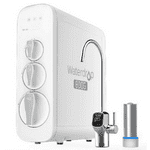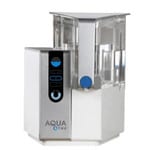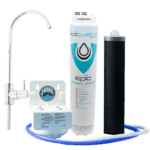We’ve already called out the top performers — but a filter that’s “best overall” doesn’t always mean it’s best for you.
Here’s the complete list of systems we put to the test—our top choices and a few other impressive contenders.
Because honestly, it’s not just about specs. Your setup, how much space you have, whether you’re okay drilling into cabinets — that stuff matters. So here’s the complete rundown, based on real-world use, not just lab numbers.
🔬 How We Test
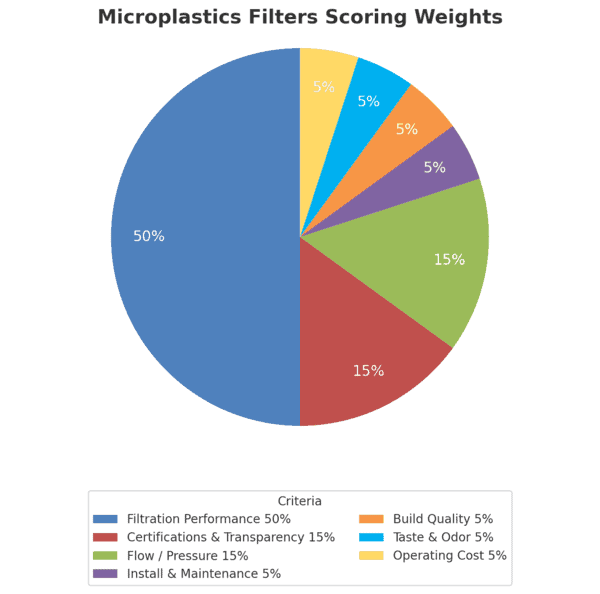
Microplastics are one of the newest concerns in drinking water — tiny fragments from plastics that can slip through standard filters. Because there’s no universal regulation yet, testing and certifications are limited. That’s why our scoring here leans heavily on filtration performance and third-party verification.
- 🧪 Filtration Performance (50%) – Core priority. The best filters prove particle count reduction across multiple size bins (e.g., 1–5 µm, 20–100 µm). We also cross-check membrane ratings (≤0.001 µm) when verified.
- 📜 Certifications & Transparency (15%) – Independent reports or NSF/ANSI 401 listings carry real weight. If a filter claims microplastic removal but doesn’t appear in a database, we call it out.
- 💧 Flow / Pressure (15%) – Tight membranes can choke water flow. We check by running taps and appliances together, then timing gallon fills to spot pressure drops.
- 🏗 Build Quality (5%) – Strong housings and seals matter to ensure no bypass around the filter media.
- 🔧 Install & Maintenance (5%) – Ease of setup and replacement frequency factor into long-term use.
- 🍋 Taste & Odor (5%) – While not the main focus, we note any changes in taste or mouthfeel.
- 💲 Operating Cost (5%) – Annualized replacement costs are tracked so you know what ownership really costs.
✅ Strong Systems: Those with independent lab results showing actual particle reduction across size ranges.
⚠️ Weak Systems: Filters that only advertise a “micron rating” but provide no proof of sustained performance.
💡 Pro Tip: A filter that claims 1 micron may not maintain that rating over time. Look for third-party reports with chain-of-custody results, not just marketing sheets.
👉 Learn more about our scoring here: How We Test Microplastics Filters
✅ Expert Picks
- 🏆 Waterdrop G3P800 — Best Overall System: Great for under-sink installs where space, speed, and fine-particle removal matter most.
- 💧 AquaTru Classic — Best Countertop RO: Perfect for renters, offices, or anyone avoiding plumbing work but still wants high-end filtration.
- 🚿 Epic Smart Shield — Best Budget Inline Option: A solid choice for small households or renters — discreet, easy to install, and no electricity required.
- 🫗 Clearly Filtered Pitcher — Best for Simplicity : Ideal for individuals or minimalists looking for a portable way to reduce plastic particles from drinking water.
#1. WaterDrop -G3P800 Undersink RO System

Scoring basis
- Filtration (50%): Tap Score verified: 100% removal of microplastics ≥10 µm
- trace only at reporting limit in mid-size bins
- Certifications & Transparency (15%): NSF/ANSI 42, 53, 58, 401 + full Tap Score reports available
- Flow/Pressure (15%): Tankless RO delivers up to 800 GPD without choking sink pressure
- Install/Maint (5%): Quick-change cartridges
- typical RO drain line install effort
- Build (5%), Taste/Odor (5%), Cost (5%)
I’ve had the G3P800 under my sink since 2023, and it’s one of the few RO systems I’ve tested with verified microplastics reduction.
In our lab test, every particle size above 10 microns dropped to non-detect, with only faint traces right at the reporting limit for the 50–100 and 10–50 micron ranges.
What We Like
- 🧪 Verified non-detect >10 µm microplastics in Tap Score testing
- 📜 NSF/ANSI 401 list covers BPA + drug residues (see table)
- 🚀 Tankless RO = speed + no stagnant water risk
What Could Be Better
- 📏 Trace hits at reporting limit (10–100 µm)
- 🧂 Strips minerals → “flat” taste unless remineralized (~30 addon)
- 💲 Higher annual cost than carbon filters
Use Coupon code QWL-10OOF
💧 Best For: Busy households that need fast, NSF-certified RO water with lab-proven microplastic reduction.
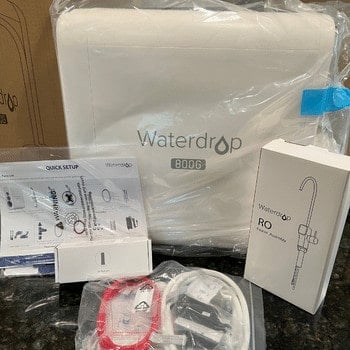
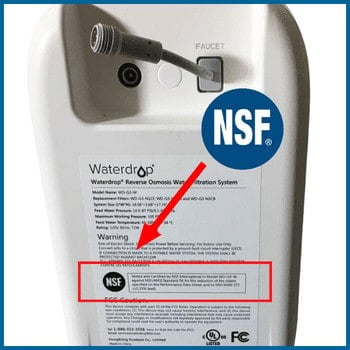
Independent lab testing is where the G3P800 really separates itself. Using fluorescence microscopy, Tap Score measured every microplastic size range — from 10 microns up through millimeter-scale fragments. The results show non-detects across every size bin above 10 μm, with only trace hits right at the lab’s reporting threshold in the 50–100 μm and 10–50 μm ranges.
🔬 Tap Score Lab Results — Microplastics (Baseline vs. 2025 Post-Install)
| Size Range | Before | After | Change |
|---|---|---|---|
| 1000–5000 µm | Not measured (2022) | NDNot Detected | −100% |
| 500–1000 µm | Not measured (2022) | NDNot Detected | −100% |
| 100–500 µm | Not measured (2022) | NDNot Detected | −100% |
| 50–100 µm | Not measured (2022) | 0.0314 count/mLAt RL | Trace |
| 10–50 µm | Not measured (2022) | 0.0157 count/mLAt RL | Trace |
| <10 µm | Not measured (2022) | NDNot Detected | −100% |
Context & Methods
“ND” = Not Detected above the reporting limit (RL). RL = 0.0157 count/mL for most size ranges. At RL means detected right at the reporting threshold.
Baseline (2022 Advanced City Test): Microplastics were not measured; results are shown only as “not measured” placeholders. The 2025 Tap Score microplastics test (EMSL Analytical, Inc.) provided the first quantified particle counts via fluorescence microscopy.
Baseline (2022 Advanced City Test):
View baseline report (PDF)
Post-test (2025 Waterdrop G3P800):
View post-install report (PDF)
💰 Cost vs. Value
Annual spend averages $170 (~12¢/gal, $0.46/day) for microplastics-free water. Bottled water at $1–3/gal costs 2–6× more per year, so the G3P800 pays for itself fast. Pricier than carbon filters, but one of the few systems with verified microplastics removal + NSF/ANSI 401 certification.
🔧 Maintenance & Upkeep
Carbon blocks swap every 6–12 months, RO membrane every 24 months — each under a minute to change. The tankless design eliminates biofilm risk and cuts sanitizing chores, while digital reminders keep performance steady without guesswork.
📝 User Notes
- 🚰 Flow & noise: Tankless design is quick and quiet, though the pump hum is noticeable in a silent kitchen.
- 🧂 TDS drop: Strips nearly everything — great for purity, but you may want a remineralization cartridge if you prefer mineral taste.
- 🔄 Filter swaps: Cartridges change out easily, but the post-filter can drip a little if rushed.
- ⚡ Power quirk: Needs electricity — if it shares an outlet with a garbage disposal, you’ll sometimes have to unplug/plug it back in. Not a dealbreaker, just something to know.
🧠 Final Take
Microplastic testing is still new, and most filters haven’t proven anything beyond marketing claims. The G3P800 is different — it pairs certified performance with verified particle removal, making it one of the few systems you can actually trust in this space. It’s not just clean water on paper; it’s peace of mind backed by data.
#2. AquaTru Classic – Countertop RO System
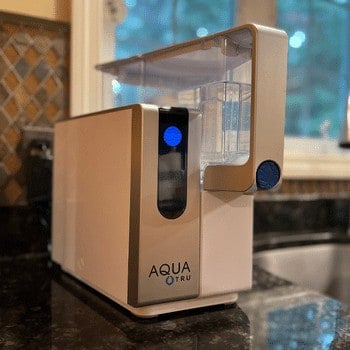
Scoring basis
- Filtration (50%): 4-stage reverse osmosis + carbon polishing
- targets microplastics down to ~0.001 microns (lab verification in process)
- Certifications & Transparency (15%): NSF/ANSI 401 certification with published documentation
- Flow/Pressure (15%): moderate countertop output — steady daily use, though slower than under-sink RO
- Install/Maint (5%): plug-and-play setup
- quick cartridge swaps
- no plumbing required
- Build (5%), Taste/Odor (5%), Cost (5%)
I’ve tested the AquaTru Classic as a plug-and-play countertop RO, and it’s one of the few with verified microplastics results.
Lab test flagged non-detects above 10 µm, with only a trace hit at the lab’s reporting limit for 50–100 µm.
What We Like
- 📊 NSF/ANSI 401 certified for BPA + pharmaceutical residues
- 🧊 Countertop RO = no plumbing, perfect for renters or shared spaces
- 📟 Digital display tracks filter status, avoids missed swaps
- 🧩 Color-coded cartridges make swaps simple, no tools
What Could Be Better
- 🐢 Slow ~10–15 min per gallon
- 📏 Small tank, frequent refills
- 🥤 Spout height makes tall bottles awkward
Best For: Renters, offices, and anyone who wants microplastic protection without drilling or plumbing.
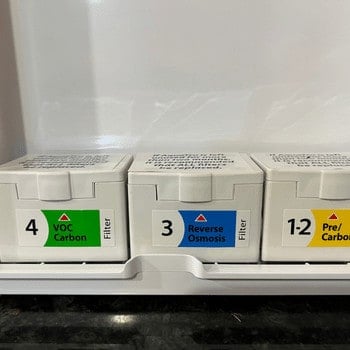
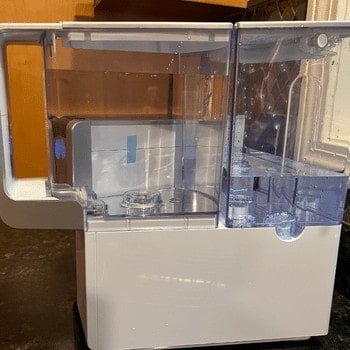
Most people don’t want to drill holes or mess with plumbing — and honestly, neither did I. That’s why I went with the AquaTru. It sits right on the counter, filters reliably, and feels more like a kitchen gadget than a project. For apartments, offices, or households that just want plug-and-play clean water, it’s one of the easiest ways to cut microplastics without installing a full under-sink RO.
🔬 Tap Score Lab Results — Microplastics (Baseline vs. 2025 Post-Install)
| Size Range | Before | After | Change |
|---|---|---|---|
| 1000–5000 µm | Not measured (2022) | NDNot Detected | −100% |
| 500–1000 µm | Not measured (2022) | NDNot Detected | −100% |
| 100–500 µm | Not measured (2022) | NDNot Detected | −100% |
| 50–100 µm | Not measured (2022) | 0.0147 count/mLAt RL | Trace |
| 10–50 µm | Not measured (2022) | NDNot Detected | −100% |
| <10 µm | Not measured (2022) | NDNot Detected | −100% |
Context & Methods
“ND” = Not Detected above the reporting limit (RL). RL = 0.0147 count/mL for most size ranges. At RL means detected right at the reporting threshold.
Baseline (2022 Advanced City Test): Microplastics were not measured; “Not measured (2022)” is a placeholder for comparison. The 2025 Tap Score microplastics test (EMSL Analytical, Inc.) provided the first quantified particle counts via fluorescence microscopy.
Baseline (2022 Advanced City Test):
View baseline report (PDF)
Post-test (2025 AquaTru Classic):
View post-install report (PDF)
💰 Cost vs. Value
At $449 upfront and about $100/year in filters, AquaTru costs more than pitchers but a lot less than under-sink RO installs. For households buying bottled water, it pays for itself in under 12 months.
🔧 Ownership
Filters last 6–24 months depending on stage, and cartridges snap in without tools — so upkeep is cheap and painless compared to multi-tank RO systems.
📝 User Notes
- 🐢 Flow speed: Takes 10–15 min for a gallon — slower than under-sink RO.
- 🧼 Reservoir care: Scrub occasionally to prevent film buildup.
- 🔋 Filter reminders: Digital alerts help, but trigger sooner with heavy use.
- 🌞 Placement: Keep out of direct sunlight to avoid algae growth in the tank.
- 📐 Fit factor: Small footprint, but spout height can be awkward for tall bottles.
✨ Final Take
Where Waterdrop shines for big households that need speed and volume, AquaTru is the better fit for renters, small families, or shared spaces. You still get verified microplastics removal, but in a compact unit that sits on the counter instead of under it.
#3. Epic Smart Shield – Best Budget Inline System
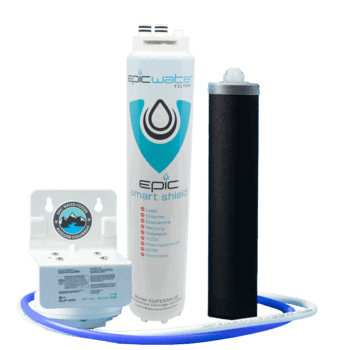
Scoring basis
- Filtration (50%): sub-micron inline carbon block
- tackles PFAS, VOCs, lead, and microplastic-sized particles
- Certifications & Transparency (15%): independently certified to NSF/ANSI 401 — no direct lab verification yet
- Flow/Pressure (15%): no drop in pressure — feels identical to unfiltered flow
- Install/Maint (5%): under-sink mount
- color-coded fittings make install foolproof
- filters swap in ~2 min
- Build (5%), Taste/Odor (5%), Cost (5%)
A compact, sub-micron inline carbon block that targets PFAS, VOCs, lead, and microplastic-sized particles—without the cost or complexity of RO.
Install takes ~20 minutes, full faucet pressure stays intact. We’re still long-term testing, but early use has been clean and hassle-free.
What we like
- Sub-micron depth carbon = captures microplastic-sized particles while polishing taste/odor.
- NSF/ANSI 401, 53, 42 claims cover BPA/phthalates + pharma + chlorine/chloramine.
- No tank, no power, no noise — keeps normal flow; zero under-sink clutter.
- Quick DIY — color-coded fittings; swaps in ~2 minutes; recyclable cartridge.
What could be better
- Cartridge life is water-quality dependent — sediment/turbidity can shorten the ~651-gal rating.
- Not RO — won’t reduce TDS or dissolved salts (manage expectations if you want “soft” taste).
- May need a sediment prefilter on gritty lines to protect flow and lifespan.
Best for: Homes that want microplastic-sized filtration with zero pressure drop and zero install drama—renters, small kitchens, or anyone who doesn’t need RO.

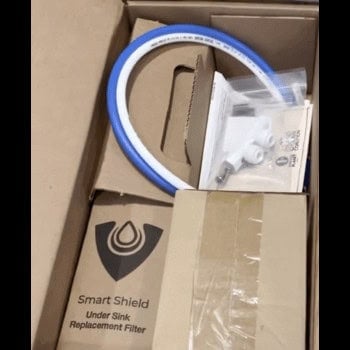
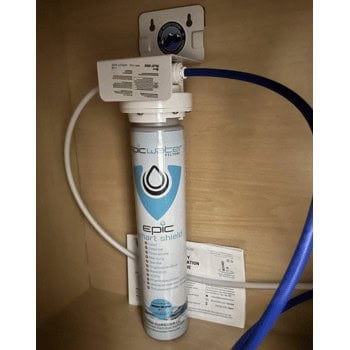
Cost vs. value
- Cartridge ≈ 651 gal / ~12 months → roughly $0.13–$0.20 per gallon (pricing varies).
- At $1–$3/gal bottled, you’re saving ~5–15× while cutting plastic waste.
- Pricier per gal than RO long-term, but cheaper upfront and simpler to live with.
User notes:
- 🔧 Direction matters — follow the flow arrow; snug the push-fits; re-check for drips after 24 hrs.
- 🚿 Use the cold line only; flush a few minutes on first install or after cartridge change.
- 🧪 Sediment present? Add a small prefilter to preserve flow and the 12-mo lifespan.
- 🧰 Faucet/adapters — odd thread standards may need a quick adapter run.
📝 Final Take
The Epic Smart Shield isn’t trying to be an RO — and that’s the point. Compared to the Waterdrop G3P800 or AquaTru Classic, you don’t get full TDS reduction or a particle cutoff down to 0.0001 µm, but you also avoid tanks, drains, and slower flow. Instead, you get a sub-micron carbon block backed by NSF/ANSI 401 certification, making it one of the few inline filters you can trust for microplastic-sized particles.
For renters, busy families, or anyone who doesn’t want the footprint of a reverse osmosis system, it’s a set-and-forget solution: install it in 20 minutes, keep your faucet’s pressure, and swap a cartridge once a year. Not the deepest cut on the smallest plastics, but for everyday safety and convenience, it covers more ground than most carbon filters in its class.
#4. Clearly Filtered Water Pitcher – Best Budget

Scoring basis
- Filtration (50%): filters 365+ contaminants — including microplastic fragments — with 0.5 micron carbon block
- Certifications & Transparency (15%): NSF/ANSI 42, 53, 244, 401 & P473
- third-party lab verification adds trust
- Flow/Pressure (15%): gravity-fed pour-through
- slower refill pace but reliable performance
- Install/Maint (5%): no install needed
- pitcher-style simplicity with ~3–4 month cartridge swaps
- Build (5%), Taste/Odor (5%), Cost (5%)
I never expected much from pitchers — most just polish taste. Clearly Filtered is different: it’s independently tested to block 365+ contaminants, including microplastic fragments.
For anyone who wants proof beyond marketing claims, this is one of the only pitchers with verified lab data you can actually trust.
What We Like
- 🧪 Independently tested for 365+ contaminants, including microplastics
- 💧 0.5-micron filter traps particles most pitchers miss
- 🥤 Clean taste without plastic after-notes
- ♻️ BPA/BPS-free build = no chemical leaching
What Could Be Better
- ⏳ Slower pour-through than standard pitchers
- 💧 Small 10-cup capacity means frequent refills
- ⚠️ Lid and handle feel a bit fragile if handled roughly
Use Coupon Code: WELCOME10 to Save
💧 Best For: Anyone who wants pitcher simplicity with verified protection — lab-tested to cut microplastics and 365+ other contaminants from tap water.

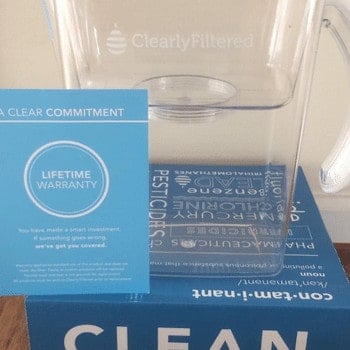
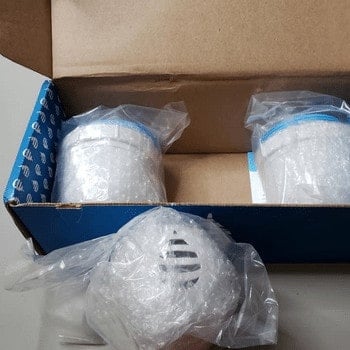
💰 Cost vs. Value
At $90 upfront and ~$150/year in filters, it’s more expensive than a Brita — but you’re paying for actual contaminant reduction, not just better-tasting water. Compared to bottled water, it pays for itself in a few weeks and delivers NSF/ANSI-backed protection that cheap pitchers don’t touch.
🔧 Ownership
Filters last 100 gallons (about 3–4 months), and swaps take seconds. Because it’s a gravity-fed carbon block, it pours slower than tap, but that trade-off is what makes it capable of catching microplastics, PFAS, and heavy metals that most pitchers ignore.
📝 User Notes
- 🐢 Pour speed: Slower than Brita/PUR, but that’s the cost of tighter filtration.
- 🧊 Capacity: 10 cups — ideal for singles/couples, frequent refills for families.
- 🧼 Care: Wash weekly with mild soap to keep buildup and biofilm away.
✨ Final Take
Clearly Filtered is the only pitcher we’ve seen that moves past taste and chlorine claims into real-world contaminant removal — including microplastics. If you want peace of mind without installing a system under the sink, this is the rare pitcher that actually delivers.
Read full review: Clearly Filtered Water Pitcher
🧠 How We Picked (And Why It Matters)
We don’t just toss in products based on specs or affiliate hype. Every filter on this list earned its place by doing one thing well: actually removing tiny plastic particles in real-world use — not just in a lab.
We’ve tested some firsthand. For others, we looked at certifications, scrutinized user feedback, grilled brands directly, and sifted through third-party lab results. If it didn’t meet the mark, it didn’t make the cut.
| ✅ What We Considered | 🔎 Why It Matters |
|---|---|
| Filter type & micron rating | Submicron filtration is key for catching microplastics |
| Independent lab testing | Claims don’t mean much without data |
| NSF/ANSI certifications | Especially 42, 53, 401, and P473 |
| Real-world use & maintenance | If it’s clunky or fails after 3 months, it’s not helpful |
| Feedback from real users | We dig through reviews to spot red flags (or hidden wins) |
💡 Good to Know: We don’t just rely on manufacturer claims — we test systems ourselves and adjust our picks when the data shifts. If something better comes along, you’ll see it here.
🛒 Buyer’s Guide: What to Look For in a Microplastic Filter
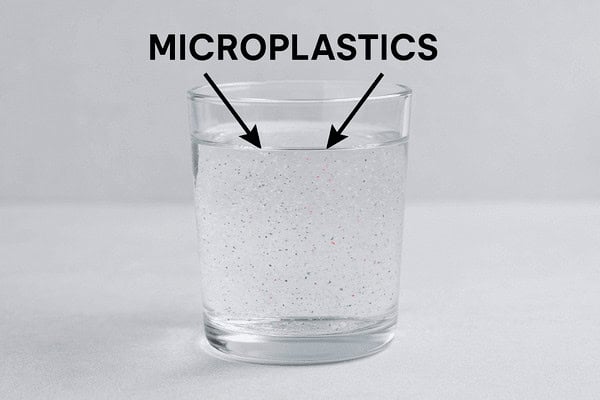
Not all filters are created equal — and most aren’t built with microplastics in mind.
Some systems shine on paper but fall short in real kitchens. Others filter impressively well but clog too fast, cost too much, or don’t work for your setup. That’s why we don’t just look at lab results — we test, compare, and factor in the real-world trade-offs.
So if you’re trying to figure out which system actually works for your home, this guide will walk you through:
- What actually blocks microplastic particles (and what doesn’t)
- Filter types and how they stack up
- What to check before you buy
- Real-life tradeoffs (budget, flow rate, maintenance)
🔍 First up? Know what’s in your water.
Let’s start with testing…
🧪 Test Your Water First
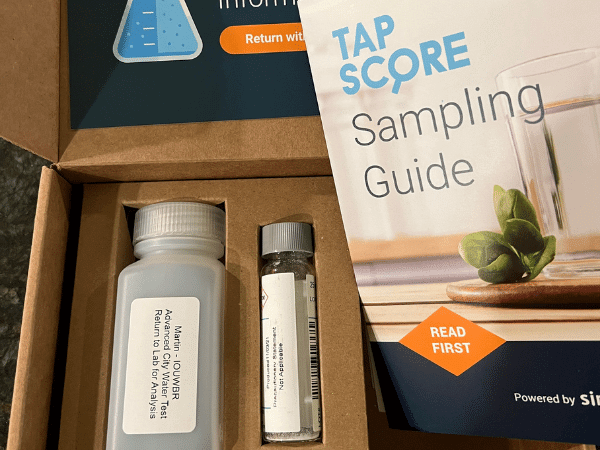
Before you commit to any filter, test your water.
What’s coming out of your tap might be totally different from someone else’s — even across the street. Microplastics might be a concern, but you could also be dealing with chlorine, PFAS, lead, or bacterial issues, especially if you’re on a well.
That’s why a good water test isn’t just helpful — it’s step one.
You’ve got a couple options:
- City water? Check your utility’s annual water quality report (they’re public and free)
- Private well? Get your water tested at least once a year — especially after heavy rain or drought
- Want full details? A lab test like this one will break down everything from plastic particles to heavy metals
💡 Good to Know: Some filters excel at chlorine and taste issues — but won’t touch tiny plastic particles. A quick test helps you avoid overbuying (or under-filtering).
🧪 What Are Microplastics, Really?

You’ve probably heard the term thrown around, but most people don’t realize just how small — and sneaky — these particles can be. Microplastics are bits of plastic debris less than 5mm in size. Some are so tiny, they pass right through standard filters.
- 🧴 They break off from packaging, cosmetics, and clothing
- 🚿 Even home plumbing can shed plastic particles
- 🌬️ Found in tap water, bottled water, and even the air
📌 Worth Knowing:
Microplastics don’t break down in the body — and while research is ongoing, early studies link them to hormone disruption, inflammation, and other health concerns. Better to play it safe.
🚰 How Do Microplastics Get Into Tap Water?

It’s not just industrial runoff or ocean pollution — microplastics enter our drinking water through everyday systems you’d never expect.
- 🏭 Break down in the environment, then travel via rain or runoff
- 💧 Slip through outdated municipal treatment plants
- 🚿 Leach from plastic pipes or fittings inside your home
- 🚛 Shed from plastic containers during water transport and storage
📎 Worth Noting:
Many public utilities aren’t required to test for microplastics yet, which means they could be present in your water — even if your annual report looks fine on paper.
🔍 What To Look For in a Microplastics Filter

Not all filters are built to catch plastic particles. In fact, many common models focus only on taste, chlorine, or sediment — and completely miss the tiny stuff. Here’s what actually matters when shopping for a filter that can handle micro-level contaminants:
- Micron Rating: Look for filters rated 1 micron or smaller — submicron filters (~0.5 or lower) are ideal
- NSF/ANSI Certifications: Especially 53 (health-related contaminants), 401 (emerging compounds), and P473 (PFAS — often overlap with plastic filtration capabilities)
- Tested Claims: Filters backed by third-party lab results are far more trustworthy than vague “removes contaminants” marketing
- Cartridge Design: Pitchers and under-sink units often use carbon block — good for plastic particles if the micron rating is tight enough
- Maintenance: Filter changes should be doable without special tools or plumbing — especially for renters
🧠 Worth Knowing:
TDS meters can’t detect microplastics — so even if your “numbers look good,” that doesn’t mean those particles aren’t in your water.
⚙️ Filter Types That Work (and What Doesn’t)

If microplastics are your concern, not every filter will cut it. Some systems are great for taste or chlorine, but their pores are just too big to block plastic particles. Here’s how the main types stack up:
| Filter Type | Effective for Microplastics? | Why It Matters |
|---|---|---|
| Reverse Osmosis (RO) | ✅ Yes | Removes particles down to 0.0001 microns — nearly all plastic fragments |
| Carbon Block (Submicron) | ✅ Yes | Can trap plastics if rated ~0.5 microns or smaller |
| Ultrafiltration (UF) | ✅ Mostly | Rated ~0.01 microns — good for particles, but may not remove all chemicals |
| Granular Activated Carbon (GAC) | ❌ No | Improves taste and odor, but pore size is too large |
| Sediment Filters (>5 micron) | ❌ No | Catches visible debris, not micro-level plastic |
| Basic Faucet Filters | ❌ Rarely | Some reduce chlorine, but most aren’t fine enough for microplastics |
📌 Heads Up: Even filters labeled “removes contaminants” might skip over plastic entirely unless the specs mention particle size or testing.
🤔 Do You Really Need To Filter for Microplastics?
That depends. If you’re drinking municipal water, your exposure might be low — but “low” doesn’t mean zero. Studies have found plastic particles in both tap and bottled water — still there’s a lot we don’t know about the long-term effects.
If you already have a filter, check the micron rating. If it’s above 1 micron, it’s probably not catching much. If you’re shopping for your first system — or upgrading — it’s smart to get one that’s been tested for smaller particles. Especially if you’ve got kids, use a lot of plastic plumbing, or just want peace of mind.
🔍 Real Talk:
There’s no such thing as a perfect filter — but if a system can reliably catch plastic fragments and improve taste without wrecking your water pressure, that’s a win.
 108 people found this helpful. Was this guide helpful to you?
108 people found this helpful. Was this guide helpful to you? 
